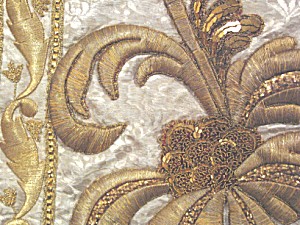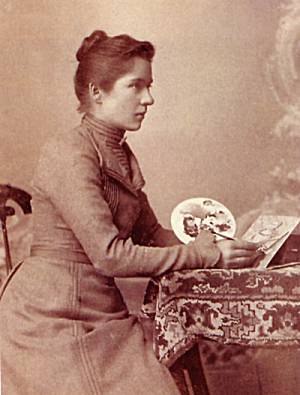
| ANNE WANNER'S Textiles in History / book reviews, articles |
| Die
Paramentikwerkstatt Glattburg, by: Anne Wanner,
in: Benediktinerinnen-Abtei St. Gallenberg in Glattburg
bei Oberbueren, St. Gallen 2004, p. 254-285, colour
photos, in German, ISBN 3-906616-67-3 |
|
| Workshop on
vestments at Glattburg, in the eastern part of
Switzerland: The convent of the Benedictine sisters was founded in 1754 in a small place in Switzerland called Libingen. In 1781 the sisters moved to the former castle Glattburg, also in the eastern part of Switzerland. From the beginning the nuns embroidered vestments. Some precious chasubles from the 18th c. are still preserved. As the abbey was celebrating its 250th anniversary in the summer of 2004 a history of the convent was published on the occasion. The documents preserved at Glattburg and also in archives in St. Gallen clearly show, that the sisters already embroidered in an early time of development for many smaller and bigger churches in the surroundings. This became very important in Napoleonic times when the nuns had to prove that they were able to live by the work of their own hands. In this way the convent was able to continue to exist until the present day, whereas the Abbey of St.Gallen, which had close relations with the convent of the sisters, was sacked in the beginning of the 19th c. |
Chalice veil,
belonging to the vestment of Libingen, |
Detail of
Chasuble of Libingen, |
Chasuble, 2nd
half of 18th c., |
Detail of
Chasuble, 2nd half of 18th c., |
Chasuble, mid 19th c., Abbey of Glattburg |
|
Black Calice
Veil, around 1846, |
Black Chasuble,
around 1846, An almost identical Chauble is preserved at Bischofszell, Switzerland |
| A second important period
can be found at the time of World War I, which was also
the time of machine embroidery. In St.Gallen the firm of
Arnold Fraefel was producing and selling goods
according to church requirements. This
manufacture, founded in 1883, specialised in church
vestments, which were hand embroidered and machine
embroidered. Around 1915 it became impossible to
commission embroideresses in Belgium and other European
countries. Fraefel therefore started his teamwork with
the sisters at Glattburg. In the convent many documents of the past are still preserved. One can find quite a great number of designs for vestments, one of them with a clear copyright for Fraefel & Co., others with inscriptions of the church which ordered the vestment. During these years until about 1940, the sisters were delivering their work to Fraefel and he was selling the produced vestments all over the world. The commissions for the embroideresses from the surrounding neighbourhood were diminishing in this second period, but in several churches of eastern Switzerland vestments made at Glattburg can still be found. |
 Marie Thoma (Sr. Benedicta) as young textile designer before she entered the convent, 1902 |
It is also
known that sister Benedicta Thoma (1880-1946), the most
important embroideress at Glattburg, learned to embroider
in the Fraefel Manufactury in St. Gallen before she
entered the convent. A chasuble, a cope, and veils are
preserved together with the designs at Glattburg. |
Center of
Humeral, around 1920 |
Chasuble around
1920, Abbey of Glattburg |
|
|
Black chasuble,
made around 1920 in Glattburg, Pattern of this
kind could be ordered. |
Detail from
chasuble with Madonna Embroidered with
chainstitch by chainstitch machine. |
| home content | Last revised January 29, 2005 | For further information contact Anne Wanner wanner@datacomm.ch |